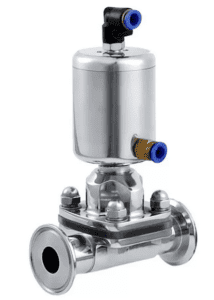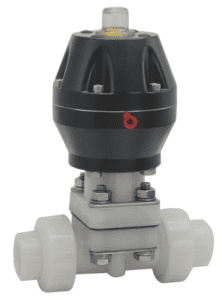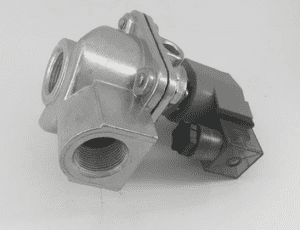Pneumatic Diaphragm Valve
Pneumatic Diaphragm Valve
NTGD is professional pneumatic diaphragm valve manufacturer, should you have any inquiry relate with our valves, please feel freeto contact us
What is a pneumatic diaphragm valve?
A pneumatic diaphragm valve is a valve that operates by using a pneumatic actuator. The actuator is placed on top of the valve and its work is to provide the torque that the valve needs to open and close the fluid flow. The actuator uses compressed air to produce the force that operates the valve. A pneumatic diaphragm valve uses a diaphragm component to regulate fluid flow. The diaphragm is connected to the actuator through a compressor and stem. This valve can work on different types of media ranging from solids, gases, and liquids. The diaphragm operates by making linear movement upwards and downwards. Pneumatic diaphragm valve manufacturers produce this valve using different materials from metallic, rubber, and plastics. The choice of the material used to make the valve dictates the area of application. Some of the applications of these valves are foods, pharmaceuticals, chemicals, agriculture, electronics manufacturing, and water supply among others.
Construction of a pneumatic diaphragm valve
A pneumatic diaphragm valve is made up of a pneumatic actuator and the valve itself. The valve consists of various parts among them valve body, bonnet, stem, compressor, diaphragm, valve ports, gaskets, connecting elements, and seals. The body and bonnet are the components that are used to house the internal parts of the valve. The body contains the inlet and exit ports. The ports have elements for connecting the valve to the pipe. The connecting elements are mostly screw threads, bolts and nuts.
The bonnet is placed on top of the valve body as shown in the figure below. The bonnet serves to house internal parts that are not wetted by the fluid like stem, seals, and compressor. The stem is connected to the actuator and its work is to transmit power from the actuator to the diaphragm through the compressor. Pneumatic diaphragm valve manufacturers design the stem with threads. These threads provide the rotary motion needed to enhance the up and downwards motion of the diaphragm to operate the valve. The stem has its bottom end connected to a compressor component. This helps the compressor get the power to operate the diaphragm from the actuator via the stem.

How does a pneumatic diaphragm valve work?
This valve operates by use of compressed air. The air is compressed in a pneumatic actuator. The actuator is made up of air chambers and a piston or diaphragm. The compressed air forces the diaphragm or piston to move resulting to rotary motion. This rotary motion or torque is then transmitted via the stem and compressor to the diaphragm where the valve is forced to open or close. To open the valve, the stem is rotated in a clockwise direction. This forces the compressor and diaphragm to move upwards. The valve then becomes open for fluid flow. To close the valve, the actuator reverses the direction of rotation forcing the diaphragm to move downwards to create a tight seal with the body. This then prevents any further fluid flow. For throttling fluid flow, the diaphragm lifts slightly to allow a certain amount of fluid to flow through the valve.

Types of the pneumatic diaphragm valve
Weir-type pneumatic diaphragm valve
This is the most commonly used pneumatic diaphragm valve. This valve is designed with a raised lip. The raised lip provides a surface on which the diaphragm rests when the valve is closed to create a tight seal against fluid flow. Pneumatic diaphragm valve manufacturers design the diaphragm of this valve with strong materials to make it withstand high pressure and vacuum applications. The reason this type of valve is very common is its reliability in providing a tight seal against fluid flow. This valve is also very good at throttling fluid flow because of its reliable diaphragm closure.
Pneumatic diaphragm valve manufacturers recommend the use of this valve in controlling flow of dangerous media like radioactive and corrosive media. The design of such a valve uses bonnet assemblies with tight connections. Such design ensures no fluid will is exposed to the environment in case the diaphragm ruptures. This valve is also self-draining which makes it suitable for use in applications that need high levels of hygiene like food processing. However, when this valve is used in handling solids and viscous fluids it leads to blockage due to the raised lids. As such, this valve would perform well when handling homogenous and clean liquids and gases.
Figure: Weir type pneumatic diaphragm valve.
Straight through the pneumatic diaphragm valve
This is a pneumatic diaphragm valve whose body is flat at the bottom and does not have a raised lip. The fluid flows straight through the valve. The valve becomes fully closed when the diaphragm extends to touch the interior bottom-most part of the body. To help the valve have tight seals, pneumatic diaphragm valve manufacturers use a more flexible material to make the diaphragm. This diaphragm is replaced frequently as its life service is short. This valve is good at handling solids and viscous liquids that need no obstruction on their flow path. The lack of raised lip makes the valve suitable for use in such applications of solids and viscous fluids as there are no obstructions or interference when the flow path is reversed.
Figure: Straight through pneumatic diaphragm valve.
Plastic pneumatic diaphragm valve
This is a special type of pneumatic diaphragm valve that is made of plastic materials. Such plastic materials include polyvinyl chloride and Polytetrafluoroethylene. This type of valve is used because of its excellent resistance to corrosion and lightweight (due to low density of plastics). As such, this valve can be used in applications involving corrosives like acids and where light weight is required. However, this valve is weak against high temperatures and thus plastic pneumatic diaphragm valve manufacturers recommend its use at only low temperatures.
Figure: Plastic pneumatic diaphragm valve.
Right angle pneumatic diaphragm valve
This is a pneumatic diaphragm valve that has the inlet and outlet ports aligned at right angles. This valve is used where the direction of flow needs to be turned to an angle of 90o degrees. It can also be used to serve as a pipe joint and valve at the same time thus reducing the cost of purchasing both valve and joint.
Figure: Right angle pneumatic diaphragm valve.
Rubber-lined pneumatic diaphragm valve
This is a pneumatic diaphragm valve that has its interior lined with rubber material. Most pneumatic diaphragm valve manufacturers design the diaphragm from rubber materials. This valve is suitable for use in low temperatures and corrosive media. The working principle of this valve is the same as that of other pneumatic diaphragm valves. The valve can be straight through or it can be weir type.
Methods of connecting pneumatic diaphragm valves
Using threads
This is the method in which the end of the valve is designed with outer or inner threads to allow the pipe to be screwed. This is one of the simplest and most commonly used designs of pneumatic diaphragm valves.
Metallic surface seal
A metal surface seal is used with a gasket between two fittings. The gasket creates face seals on two sides of the fittings.
Compression fittings
This is the method of connecting a pipe without the use of threads or welding. The seal is created when a nut is tightened and a washer compressed around the second pipe to create a tight seal.
Socket welding
This is the method of welding the pipe and the pneumatic diaphragm valve together. This method is very reliable as it ensures zero leakage. Such a valve can be used to control the flow of highly hazardous and corrosive media without possibility of any leakage.
Bolt flange
This is the method of using bolts and nuts to tighten the pipe and the pneumatic valve together. Both the valve and the pipe have flanged ends with holes where the bolts are inserted. It offers a tight seal suitable for use in high-pressure applications.
Applications of pneumatic diaphragm valves
- Pneumatic diaphragm valves are used in foods, dairy, and beverages applications.
- These valves are used to control the flow of different products in pharmaceutical plants.
- They are used in the municipal water supply.
- Pneumatic diaphragm valves are used in wastewater treatment applications.
- These valves are used in the manufacturing of different chemicals such as acids and alkaline.
- They are used to control the flow of media during paper and pulp manufacturing.
- Pneumatic diaphragm valves are used to control the flow of water in firefighting.
- These valves are used in oil refineries.
- They are used in the manufacturing of fertilizers.
Advantages of pneumatic diaphragm valves
- They can operate on their own.
- These valves are bi-directional allowing fluid flow in either direction of the pipeline.
- Pneumatic diaphragm valves are suitable for use in many industrial applications.
- They are free from contamination making them suitable for use in food processing.
- These valves have tight seals that prevent fluid leakage.
- They can be used to control flow of semi-solids, gases, and liquids.
- They are resistant to corrosion and chemicals.
- Pneumatic diaphragm valves are easy to clean and repair.
- They are of simple and compact design.
- They are suitable for use in throttling applications.
Disadvantages of pneumatic diaphragm valves
- Pneumatic diaphragm valves are expensive relative to manual types.
- The diaphragm tends to wear rapidly when used for heavy throttling.
- The raised lip in some of these valves triggers dirt accumulation.
Troubleshooting pneumatic diaphragm valves
Seat leakage while the valve is closed
- Damaged diaphragm. Replace the diaphragm.
- Damaged body sealing surface. Replace the body.
- Impurities clogged between the body and the diaphragm. Open and close the pneumatic diaphragm valve under high pressure to clean off the dirt.
Leakage via the bonnet witness hole
- Damaged diaphragm. Replace the diaphragm.
Leakage between the body and the bonnet
- Loose bolts. Tighten the bolts to attain the torque mentioned by the pneumatic diaphragm valve manufacturer.
- Excess working pressure. Reduce the fluid pressure or replace the valve with another one that can withstand higher pressure.
Leakage via the body-pipe connection
- Damaged or worn-out gasket. Replace the gasket.
- Loose connection. Tighten the connecting elements to the torque recommended by the pneumatic diaphragm valve manufacturer.
The actuator does not operate
- Wrong actuator used. Replace the actuator with the one recommended by the pneumatic diaphragm valve manufacturer.
- Low system pressure. Ensure system pressure is at the recommended level.
- No power supply to the actuator. Connect the power supply.
- Low voltage supply. Ensure the supply voltage is as recommended by the pneumatic diaphragm valve manufacturer.
Summary
A pneumatic diaphragm valve is a type of diaphragm valve that operates by the use of a pneumatic actuator. The actuator is responsible for providing the power that is used to operate the valve. Pneumatic diaphragm valve manufacturers design this valve with an automated system that ensures that the valve can start and stop on its own as required. Pneumatic diaphragm valves work by use of a diaphragm component that works with help of a stem and compressor to create linear vertical motion. This motion is responsible for starting and stopping fluid flow. The valve opens when the diaphragm moves upwards and closes when the diaphragm moves down to create a tight seal with the body.
Pneumatic diaphragm valve manufacturers design several types among them weir type pneumatic diaphragm valve, straight through pneumatic diaphragm valve, rubber lined pneumatic diaphragm valve, and plastic pneumatic diaphragm valve among others. Applications of these valves include paper and pulp industries, chemical processing, foods and beverages, firefighting, water supply, and wastewater treatment among others. Advantages of using a pneumatic diaphragm valve are zero leakage, versatile, bi-directional flow, easy repair and cleaning, automatic operation, and simple and compact design.




